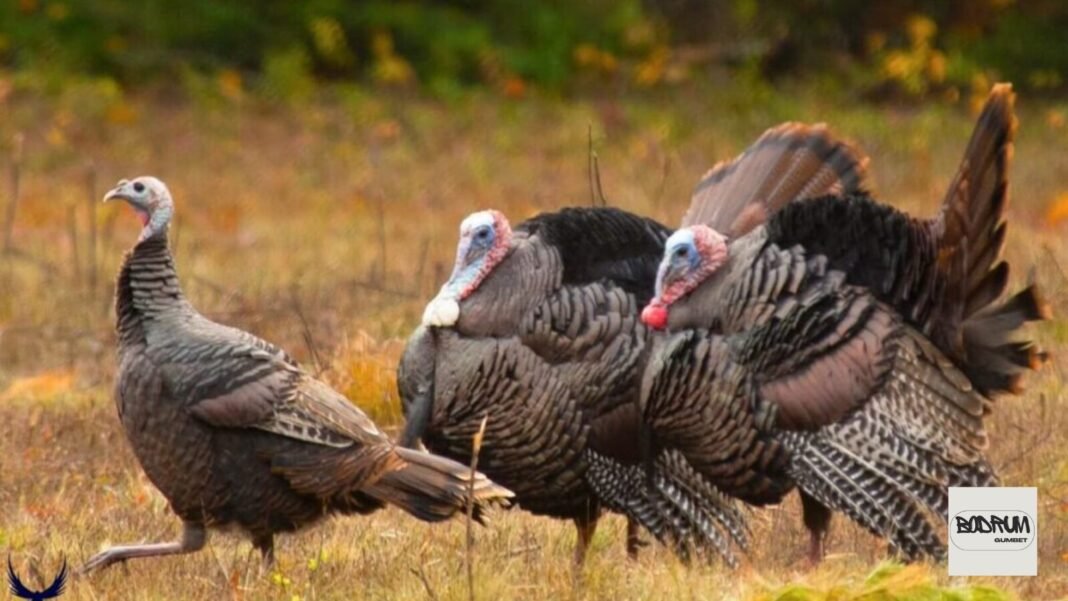Turkeys are quite gregarious animals that like company, particularly, when the weather gets chilly. During winter, it is possible to see large numbers of them; this may be a flock of up to 200 turkeys at times.
It is something that people have observed turkeys doing for so long that it appears natural. Thus, people have called a group of turkeys by a number of other names and still do so.
Did you know? All the names for groups of birds are old and have not been used for quite some time now.
But what is a group of turkeys called, actually?
Keep reading to find out.
What is a Group of Turkeys Called?
So, what do you call a group of turkeys? While the most common term is “flock,” especially for wild turkeys, there are a few other names that are used.
A “flock” is generally used to describe a group of birds that are foraging, flying, or simply staying together. Wild turkeys are known to form flocks and often exhibit a behavior called “running,” where they duck their heads and rush into dense vegetation. This behavior has led to the term “a run” being used to describe a group of wild turkeys.
When it comes to domesticated turkeys or the birds in captivity, ‘flock’ is not as frequently used as ‘group’. However, these groups are only referred to as a ‘gaggle’ or a ‘rafter’. The term ‘gaggle’ may be derived from the movement pattern of geese and turkeys.
Both birds are gregarious, noisy; and hence reared together in farms. For instance, the noisy call that turkeys make is “gah, gah”, which could have led people to use the word, gaggle.
Why is it called a Rafter of Turkeys?
Why a group of turkeys is called a “rafter”? It might seem a bit unusual at first, but there’s a simple explanation.
Wild turkeys are incredibly adaptable creatures. They spend their days on the ground, foraging for food and showing off for potential mates. But when night falls, they have a clever trick to stay safe. To avoid becoming prey for nocturnal predators, wild turkeys fly up into trees and roost high above the ground. This nightly ritual is a safety measure that has been passed down through generations.
Domesticated turkeys haven’t forgotten this ancient instinct. Even though they live on farms, they still have a strong urge to find a high place to sleep. In barns, the perfect roosting spot is often the wooden rafters near the ceiling.
When a group of turkeys flies up to these rafters, their large, feathered bodies may occupy the whole beam. This imposing view is actually what made people start referring to a group of turkeys on farms as rafter.
Although “rafter” is specialized for farm turkeys, it can occasionally be applied to wild groups of birds.
However, there are several other names for groups of turkeys, including:
- Gaggle
- Run
- Raffle
- School
- Dole
- Herd
- Gang (used for young male turkeys that band together)
- Crop (used for a new group of young turkeys)
- Brood (a group that includes a mother turkey and her young)
- Posse (used for young male turkeys that seem to be up to mischief)
- Death Row (a grim term used for turkeys destined for Thanksgiving or Christmas dinner)
Why Do Turkeys Group Themselves?
A flock of turkeys is also known as a rafter or gang and turkeys are social animals that prefer to live in groups rather than alone. Males and females, as a rule, do not frequent each other but they merge during March – April before giving birth.
One big reason why turkeys assemble is to form flocks to act as a defense against any predators. As is the case with most other animals including the fish, mammals, as well as some insects, turkey gains its strength from unity. When they are together they are likely to see more danger and their ears are likely to pick danger from far.
Suppose you are a turkey in a large group of others like it. It means that if you encounter a Bobcat or a Fox and you feel threatened by them you can warn the other people around by making a loud alarm. This is because the more birds there are the less any individual predator can Hope to have a meal that may cost him or her the life.
There is a way around this if a predator wants to try to snatch one then, it’s much harder to capture a sound, vigilant turkey when it is in a group of other birds. It was also observed that predators prefer to ambush they prey because of its effective hunting strategy. But when turkeys are together then one cannot easily attack the flock since they are always alert of any looming danger.
Of course, in the case when a turkey is left alone, that is, separated from the rest of the pack, it becomes a very endangered bird since it would attract any predator present nearby easily. And this proves why it is really necessary for turkeys to flock together!
Apart from purposes of protection, turkeys also regroup in flocks for ostentation purposes or even to seek their partners. The number of males always engage in a show of force to fathom out who among them is the most powerful and dominant. Apparently, the winner has the privilege of selecting the most suitable females for purpose of breeding.
What is a Group of Turkey Chicks Called?
Now you know what is a group of turkeys called, maybe you may wonder what a group of baby turkeys is called. Well, it’s quite simple! A group of turkey chicks is known as a brood.
The word “brood” is used to describe a group of young birds that were born at the same time and are being raised by their parents. It’s like a family of baby birds! This term isn’t just for turkeys; it can be used for the young of many different bird species.
Last Words
So now, when someone poses a question: What is a group of turkeys called? You will be able to respond with “A group of turkeys is called a rafter.” No matter whether you have to discuss them in the state of nature or in the farm, you will know what to say.
FAQs
What is the term for a group of turkeys?
A group of turkeys is known as a rafter or a flock.
Do turkeys like to be alone?
No, turkeys are usually seen together in groups. They like to hang out and eat and sleep together. Sometimes, young male turkeys might be alone because they’re looking for a girlfriend. But when female turkeys want to have babies, they might go off by themselves to find a quiet place to lay their eggs.
Why do turkeys make gobbling sounds?
Turkeys; especially the male ones often known as toms, use the gobbles to call and excite the female turkeys for mating. This behaviour called strutting is intended to show the dominance of male and their ability to best provide for the needs of their mate and offspring.

